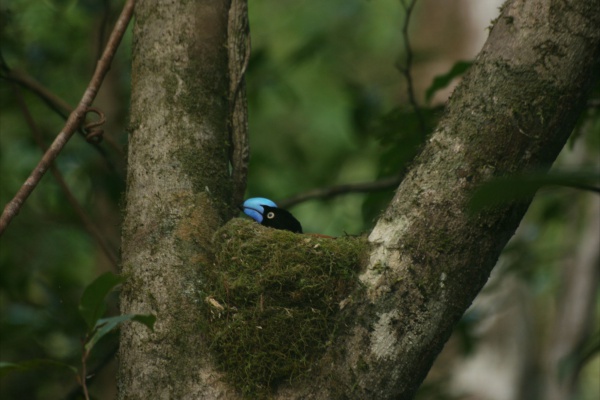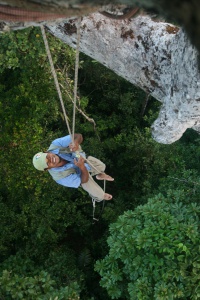North Eastern Wildlife Photography Tour - Masoala
Masoala National Park - Nosy Mangabe Special Reserve - Maroantsetra - Marojejy National Park - Daraina Reserve
14 days & 13 nights
Highlights
Masoala National Park: Observation of Red ruffed lemur and Helmet vanga
Nosy Mangabe Special Reserve: Observation of the Black-and-white ruffed lemur and tiny Antongil leaf chameleon
Maroantsetra: Observation of the colourful Tomato frog
Marojejy National Park: Observation of the Silky sifaka and Climbing mantellas
Daraina Reserve: Observation of the Golden-crowned sifaka
When do go
Feasibility: January to December
Best season: April to December
Tour description
Day 1: Tana - Maroantsetra - Masoala National Park (L/D)
Flight from Tana to Maroantsetra where a guide will meet and assist you. Transfer from the airport to the harbour (about 45 minutes) and thereafter by speedboat to reach Masoala peninsula. The boat trip lasts about 2 hours and if we are lucky we may encounter dolphins and Humpback whales during July and September. Arrival at the lodge. In the afternoon, time to relax on the beach, for swimming or exploring the surroundings. Night walk in the forest surrounding the lodge to see some night-active lemurs (Masoala mouse lemur, Brown mouse lemur, snakes and frogs). Overnight in the lodge in Masoala.
Day 2: Masoala National Park (B/L/D)
Established in 1997, Masoala National Park is Madagascar's largest protected area. The lush rainforests of northeastern Madagascar are the most diverse biome on the island. This tour offers the best of Madagascar’s fauna and flora. Many of the island’s most spectacular endemic birds are restricted to this rainforest, and there are opportunities to spot species such as Short-legged ground-roller, Scaly ground-roller, Red-fronted coua, Blue coua, Madagascar blue pigeon, Madagascar pygmy-kingfisher and Madagascar paradise-flycatcher. In the surroundings of the camp we might encounter the bizarre Lowland streaked tenrec. In the afternoon, relaxing on the beach, swimming in the bay or exploring the surroundings of the hotel. During a night walk we should find the Masoala woolly lemur, Dwarf lemur and Brown mouse lemur. The area’s reptile and amphibian fauna is equally dramatic; amongst it are countless colourful and photogenic frogs, chameleons and geckos. We may even encounter the Big-nosed chameleon and two species of incredibly camouflaged leaf-tailed gecko. Dinner and overnight in the lodge in Masoala.
Day 3: Masoala National Park (B/L/D)
Breakfast and early morning start to observe the birds in Masoala National Park. In most years we are even lucky to see a nest of the marvellous Helmet vanga. Today will be a long and strenuous day of hiking in the secondary forest inside and outside the national park, with loads of birding along the way. It will be an adventure to find the Madagascar blue pigeon, Lesser vasa parrot, Cuckoo-roller and Madagascar paradise-flycatcher. We will look for the endemic Red-breasted coua, Brown mesite and handsome Scaly ground-roller and Short-legged ground-roller. We also stand a good chance of finding the elusive Bernier's vanga, which prefers the pandanus palm swamps. Although sightings are not likely, the peninsula is also home to the magnificent rail. During the search, we will find lots of other seabirds, including Madagascar pratincole, Brown noddy, and tern colonies which are rarely seen in most of Madagascar. The afternoon is free: relax, swim or walk on the beach. Nightwalk in another part of the forest near the camp to observe the Madagascar scops-owl, Madagascar nightjar and nocturnal lemurs. Dinner and night in the lodge.
Day 4: Masoala National Park (B/L/D)
Breakfast and thereafter day excursion by traditional pirogue on the Tampolo River to visit beautiful landscapes and mangroves and then snorkelling in the coral reef. The marine protected reserve has very colourful corals, several reef fish species such as parrotfish, surgeonfish and clownfish swim amongst sea anemones and shellfish. It is possible to see Green sea turtles and dolphins. Picnic lunch based on seafood on the beach. Afternoon, visit to a plantation growing vanilla, coffee, clove and pepper followed by traditional dance and singing. Dinner and overnight in the lodge
.
Day 5: Masoala National Park - Nosy Mangabe (B/L/D)
After breakfast transfer by boat (2h) to Nosy Mangabe. If we are lucky we might see dolphins and Humpback whales from July until the first two weeks in September. Nosy Mangabe is a pristine lowland rainforest island of 5.20km² and the best place to see Black-and-white ruffed lemur and White-fronted brown lemur.
Nosy Mangabe's reptile and amphibian fauna is equally dramatic; among others, there are countless colourful and photogenic frogs, chameleons and geckos. We may encounter the Panther chameleon, Antongil leaf chameleon (the second smallest chameleon in the world), Climbing mantella, Green day-gecko and the incredibly camouflaged Common flat-tail gecko
sleeping during the day. We may see snakes such as the Madagascar tree boa and Madagascan giant hognose snake. We will also visit a Betsimisaraka tomb located in the middle of Nosy Mangabe, where we will see ancient graves of the first inhabitants of the island and the rock inscriptions left by Dutch sailors during the 16th century on a beach named Plage des Hollandais.
Picnic lunch. Dinner and overnight in the lodge
.
Day 6: Nosy Mangabe - Maroantsetra - Sambava (B/L/D)
Speedboat transfer back to Maroantsetra. Transfer to the airport and flight from Maroantsetra to Sambava. Depending on the flight schedule, we have a short stop and walk through town to explore the wonderful colourful Tomato frog endemic to the area.
Day 7: Sambava - Marojejy National Park - Camp Mantella (B/L/D)
Breakfast and departure to Marojejy National Park (5h drive). Picnic lunch on the way. Arrival at the camp. The Marojejy massif mountains are extremely rich and diverse in fauna and flora. The park is home to 12 species of lemurs and the best place in Madagascar to see the Silky sifaka, which is endemic to this region, including the five rarest primates in the world. There are over 125 bird species, 150 species of reptiles and amphibians, 30 species of palm trees and over 300 species of ferns. It is also the place to find the Takhtajania perrieri - a tree which is believed to exist on earth for about 120 million years.
From the village of Manantenina we start the hike to Camp Mantella. We discover the primary rainforest. We may have the opportunity to see several species of reptiles and amphibians, as well as bird species such as the Hook-billed vanga, White-headed vanga, Helmet vanga and Red-breasted coua. Arrival at Camp Mantella (450m altitude) and lunch. In the afternoon we discover the surroundings of Camp Mantella and visit the Humbert waterfall. Dinner and night at Camp Mantella.
Day 8: Camp Mantella - Camp Simpona (B/L/D)
Breakfast and hiking up to Camp Simpona (about 6h). We have the opportunity to see the rare Silky sifaka which is endemic to this rainforest. We stop at Camp Marojejya for lunch. In the afternoon we continue our walk to Camp Simpona. Arrival at the camp at 1250m altitude. A night walk around the camp is possible. Dinner and night at Camp Simpona.
Day 9: Camp Simpona - Summit - Camp Marojejya (B/L/D)
Early breakfast and departure for the highest elevation and rising up to the peak of Marojejy’s summit at 2132m altitude. This will be a long and strenuous day of hiking. The trails in the park and up to the summit are very hard and steep, so one needs strong physical condition. The summit is often wet and cloudy. Marojejy mountain - an astoundingly isolated island of lush rainforest. From the summit we enjoy great views onto the beautiful forest with the mighty Indian Ocean at the horizon. Spend full morning hiking and then walk back to the camp for lunch. In the afternoon we walk down to Camp Marojejya. At sunset, possibility to go for a night walk around the camp. Dinner and night in a hut at Camp Marojejya.
Day 10: Camp Marojejya - Camp Mantella - Sambava (B/L/D)
Breakfast and thereafter a long hike off the mountain, though this time with gravity on our side! Along the way, we will have chances to continue savouring the unique and rarely seen birdlife of Marojejy. We continue to leave the primary forest towards the national park boundary. Steep slopes, mud and several small river crossings will make for a truly adventurous day 5h to walk. Picnic lunch on the road and drive back to Sambava (2h). Arrival at the hotel. Night in Sambava.
Day 11: Sambava - Vohemar - Daraina Reserve (B/L/D)
Breakfast and early departure from Sambava to Vohemar (3h). Lunch on the way in a local restaurant. To reach the remote paradise of Daraina Reserve from Vohemar is not easy; this is a tough drive on a very bad road including river crossings (4h of bumpy road). Arrival at the camp. At sunset, possibility to go for a night walk in search of the rare Aye-aye. Night in Daraina Reserve.
Day 12: Daraina Reserve (B/L/D)
Breakfast and thereafter we will spend a full morning exploring Daraina Reserve (1h drive). The local NGO FANAMBY manages this reserve, which is the last natural deciduous forest, home of the endemic Golden-crowned sifaka - one of the rarest lemurs and listed as one of the 25 most threatened primates in the world. Here you may find several bird species including Hook-billed vanga, Crested coua, Madagascar kestrel,... Picnic lunch in the forest and in the afternoon back to Daraina Reserve. Night in Daraina Reserve.
Day 13: Daraina - Sambava (B/L/D)
Although it is a day’s drive back to Sambava to reach the flight, we do have time for a short stop somewhere for photos. Night in the hotel in Sambava.
Day 14: Sambava - Tana (B)
Breakfast and thereafter transfer to the airport for the flight from Sambava to Tana. End of services.
Contact
For more information about this tour please contact Pascal directly:
Email: expeditionmada@gmail.com / pascalelison@yahoo.com
Tel: +261 (0)32 57 940 24
Tel: +261 (0)34 89 704 24
Maroantsetra
Madagascar

